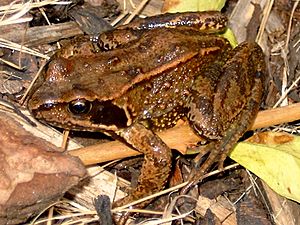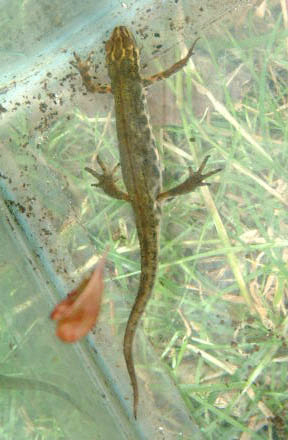List of amphibians of Ireland facts for kids
Did you know that Ireland is home to three amazing types of amphibians? Amphibians are special animals that can live both in water and on land. They start their lives in water, often as eggs and then tadpoles, and later develop lungs to breathe air, allowing them to live on land as adults. The three native species you can find hopping or swimming around Ireland are the common frog, the natterjack toad, and the smooth newt. Each of these creatures plays an important role in Ireland's natural environment.
Contents
Meet Ireland's Amphibians
Ireland's cool, damp climate is perfect for amphibians. These animals are cold-blooded, meaning their body temperature changes with their surroundings. They love places with plenty of moisture, like ponds, wetlands, and damp woodlands. Let's learn more about each of Ireland's native amphibians.
The Common Frog
The common frog (Rana temporaria) is probably the most well-known amphibian in Ireland. You can often spot them in gardens, ponds, and wet fields across the country. They have smooth, moist skin and can be different shades of brown, green, or grey, helping them blend in with their surroundings.
Common Frog Life Cycle
Common frogs lay their eggs, called frogspawn, in clumps in ponds during early spring. These eggs hatch into tiny tadpoles that look like small black dots with tails. Tadpoles live in the water, eating algae and growing quickly. As they grow, they develop back legs, then front legs, and their tails gradually shrink. Eventually, they become tiny froglets, ready to leave the water and explore the land.
What Common Frogs Eat
Adult common frogs are carnivores, which means they eat other animals. They have long, sticky tongues that they use to catch insects, slugs, and worms. They are very helpful in controlling garden pests!
The Natterjack Toad
The natterjack toad (Epidalea calamita) is much rarer than the common frog in Ireland. It's mostly found in sandy coastal areas, especially in County Kerry. Natterjack toads are different from frogs because they have warty, drier skin and prefer to walk or run rather than hop. They also have a distinctive yellow stripe down their back.
Natterjack Toad Habitat
Unlike common frogs, natterjack toads need very specific habitats. They like sandy areas with shallow, warm pools of water for breeding. These pools often dry up in summer, which means the tadpoles have to grow very quickly. Their loud, rasping call, which sounds like "crek-crek-crek," can be heard during their breeding season.
Protecting Natterjack Toads
Because they need such special places to live, natterjack toads are considered an endangered species in Ireland. This means they are at a very high risk of disappearing from the wild. Conservation efforts are in place to protect their habitats and help their populations grow.
The Smooth Newt
The smooth newt (Lissotriton vulgaris vulgaris) is the third native amphibian in Ireland. Newts look a bit like small lizards, but they are amphibians, not reptiles. They have smooth skin and a long tail. During the breeding season, male smooth newts develop a wavy crest along their back and tail, making them look quite impressive.
Smooth Newt Life Cycle
Smooth newts spend most of their lives on land, often hiding under logs or stones. However, in spring, they return to ponds and ditches to breed. The females lay their eggs one by one, carefully folding each egg into a leaf to protect it. The eggs hatch into larvae that look like tiny versions of the adults but have feathery gills for breathing underwater. They later lose their gills and develop lungs, becoming land-dwelling juveniles.
Where to Find Smooth Newts
You can find smooth newts in a variety of habitats, including ponds, slow-moving streams, and damp woodlands. They are nocturnal, meaning they are most active at night, hunting for small insects, slugs, and worms.
Why Amphibians are Important
Amphibians are a vital part of Ireland's ecosystems. They help control insect populations, and in turn, they are a food source for other animals like birds, snakes, and badgers. Their presence is also a good sign of a healthy environment, as they are very sensitive to pollution and changes in their habitat.
Protecting Ireland's Amphibians
Many amphibian populations around the world are facing threats, including habitat loss, pollution, and climate change. In Ireland, it's important to protect the places where these amazing creatures live.
- Protect their homes: Don't disturb ponds, wetlands, or damp areas where amphibians might live.
- Keep water clean: Avoid using chemicals in your garden that could wash into ponds and harm amphibians.
- Be careful: If you find an amphibian, observe it from a distance and avoid touching it, as their skin is very sensitive.
- Create a pond: If you have a garden, creating a wildlife pond can provide a safe home for frogs and newts.
By understanding and protecting these unique creatures, we can help ensure that Ireland's native amphibians continue to thrive for many years to come.




